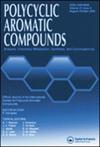Design, Synthesis, Antiproliferative Activity and In Silico Studies of 2-Oxo-1,2-Dihydroquinolin Derivatives
IF 2.6
3区 化学
Q2 CHEMISTRY, ORGANIC
引用次数: 0
Abstract
Quinolines have long been recognized as a versatile scaffold for the development of various bioactive compounds. In this context, a series of quinoline-based compounds were designed and synthesized using two key building block synthons: chalcone and thiocarbohydrazone derivatives. These compounds were synthesized following a design strategy inspired by the bis-indolyl maleimide-based PDK1 ATP-competitive inhibitor BIM-1. The final compounds were evaluated for their in vitro antiproliferative activity against MCF7 and HCT116 human cancer cell lines. Antiproliferative activity revealed that compound 11 displayed the best activity with IC50 of 7.09 and 6.18 µM against HCT116 and MCF7 cell lines respectively. Furthermore, an in silico molecular docking study was performed on the PDK1 enzyme to investigate the binding affinity of compounds at the ATP-binding site. The docking analysis provided insight into the molecular interactions and binding modes of these compounds. Compound 4 showed the highest affinity with a binding score of −11 kcal/mol and an estimated Ki of 8.65 nM. Additionally, ADME (Absorption, Distribution, Metabolism, and Excretion) predictions indicated favorable drug-likeness and oral bioavailability profiles. This study aims to contribute to the development of promising anticancer agents.
2-氧-1,2-二氢喹啉衍生物的设计、合成、抗增殖活性及硅研究
喹啉类化合物长期以来一直被认为是开发各种生物活性化合物的多功能支架。在此背景下,利用查尔酮和硫代碳腙衍生物这两个关键的构建块,设计并合成了一系列喹啉类化合物。这些化合物是根据基于双吲哚基马来酰亚胺的PDK1 atp竞争抑制剂BIM-1的设计策略合成的。最终化合物对MCF7和HCT116人癌细胞的体外抗增殖活性进行了评价。抗增殖活性表明,化合物11对HCT116和MCF7的IC50分别为7.09µM和6.18µM。此外,对PDK1酶进行了硅分子对接研究,以研究化合物在atp结合位点的结合亲和力。对接分析提供了对这些化合物的分子相互作用和结合模式的深入了解。化合物4的亲和力最高,结合分数为−11 kcal/mol, Ki值为8.65 nM。此外,ADME(吸收、分布、代谢和排泄)预测显示了良好的药物相似性和口服生物利用度。本研究旨在为开发有前景的抗癌药物做出贡献。
本文章由计算机程序翻译,如有差异,请以英文原文为准。
求助全文
约1分钟内获得全文
求助全文
来源期刊

Polycyclic Aromatic Compounds
化学-有机化学
CiteScore
3.70
自引率
20.80%
发文量
412
审稿时长
3 months
期刊介绍:
The purpose of Polycyclic Aromatic Compounds is to provide an international and interdisciplinary forum for all aspects of research related to polycyclic aromatic compounds (PAC). Topics range from fundamental research in chemistry (including synthetic and theoretical chemistry) and physics (including astrophysics), as well as thermodynamics, spectroscopy, analytical methods, and biology to applied studies in environmental science, biochemistry, toxicology, and industry. Polycyclic Aromatic Compounds has an outstanding Editorial Board and offers a rapid and efficient peer review process, as well as a flexible open access policy.
 求助内容:
求助内容: 应助结果提醒方式:
应助结果提醒方式:


